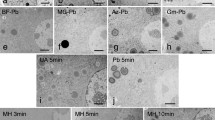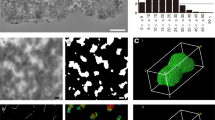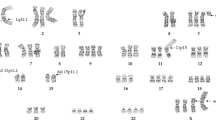Abstract
THE permanganate ion has occasionally been used in histology and histochemistry to demonstrate particular components in animal tissues1,2. In electron microscopy, potassium permanganate has been used in some fixatives3 and as a stain4. Permanganate oxidation has also been used to chemically degrade DNA5 and under certain mild conditions to oxidize preferentially pyrimidine residues, especially the thymine residue of heat-denatured DNA with a small strand break6,7.
This is a preview of subscription content, access via your institution
Access options
Subscribe to this journal
Receive 51 print issues and online access
$199.00 per year
only $3.90 per issue
Buy this article
- Purchase on Springer Link
- Instant access to full article PDF
Prices may be subject to local taxes which are calculated during checkout
Similar content being viewed by others
References
Schmidt, W. J., Zeitschr. Zellforsch. Mikroskop. Anat., 23, 261 (1936).
Lillie, R. D., Stain Tech., 26, 123 (1951).
Luft, J. H., J. Biophys. Biochem. Cytol., 2, 799 (1956).
Lawn, A. M., J. Biophys. Biochem. Cytol., 7, 197 (1960).
Jones, A. S., Ross, G. W., Takemura, S., Thompson, T. W., and Walker, R. T., J. Chem. Soc., 373 (1964).
Hayatsu, H., and Ukita, T., Biochem. Biophys. Res. Comm., 29, 556 (1967).
Iida, S., and Hayatsu, H., Biochim. Biophys. Acta, 240, 370 (1971).
Drets, M. E., and Shaw, M. W., Proc. US Nat. Acad. Sci., 68, 2073 (1971).
Sumner, A. T., Evans, H. J., and Buckland, R. A., Nature New Biology, 232, 31 (1971).
Wang, H. C., and Fedoroff, S., Nature New Biology, 235, 52 (1972).
Caspersson, T., Farber, S., Foley, G. E., Kudynowski, J., Modest, E. J., Simonsson, E., Wagh, V., and Zech, L., Exp. Cell Res., 49, 219 (1968).
Pardue, M. L., and Gall, J. G., Science, 168, 1356 (1970).
Arrighi, F. E., and Hsu, T. C., Cytogen., 10, 81 (1971).
Dutrillaux, B., and Lejeune, J., CR D-Series Naturelles, 272, 2638 (1971).
Ridler, M. A. C., Lancet, ii, 354 (1971).
Patil, S. R., Merrick, S., and Lubs, H. A., Science, 173, 821 (1971).
Schnedl, W., Nature New Biology, 233, 93 (1971).
Lomholt, B., and Mohr, J., Nature New Biology, 234, 109 (1971).
Rowley, J. D., and Bodmer, W. F., Nature, 231, 503 (1971).
Gagné, R., Tanguay, R., and Laberge, C., Nature New Biology, 232, 29 (1971).
Author information
Authors and Affiliations
Rights and permissions
About this article
Cite this article
UTAKOJI, T. Differential Staining Patterns of Human Chromosomes treated with Potassium Permanganate. Nature 239, 168–170 (1972). https://doi.org/10.1038/239168a0
Received:
Issue Date:
DOI: https://doi.org/10.1038/239168a0
This article is cited by
-
The involvement of nucleosomes in Giemsa staining of chromosomes
Histochemistry (1985)
-
A relation between G-, C-, and N-band patterns as revealed by progressive oxidation of chromosomes and a note on the nature of N-bands
Genetica (1982)
-
Chromosome delineation induced by a combined potassium permanganate-sodium bisulfite treatment
Chromosoma (1980)
-
Giemsa `and formation in M-chromosomes of Vicia faba
Experientia (1977)
-
Configurational changes in chromatids from helical to banded structures
Chromosoma (1976)
Comments
By submitting a comment you agree to abide by our Terms and Community Guidelines. If you find something abusive or that does not comply with our terms or guidelines please flag it as inappropriate.



